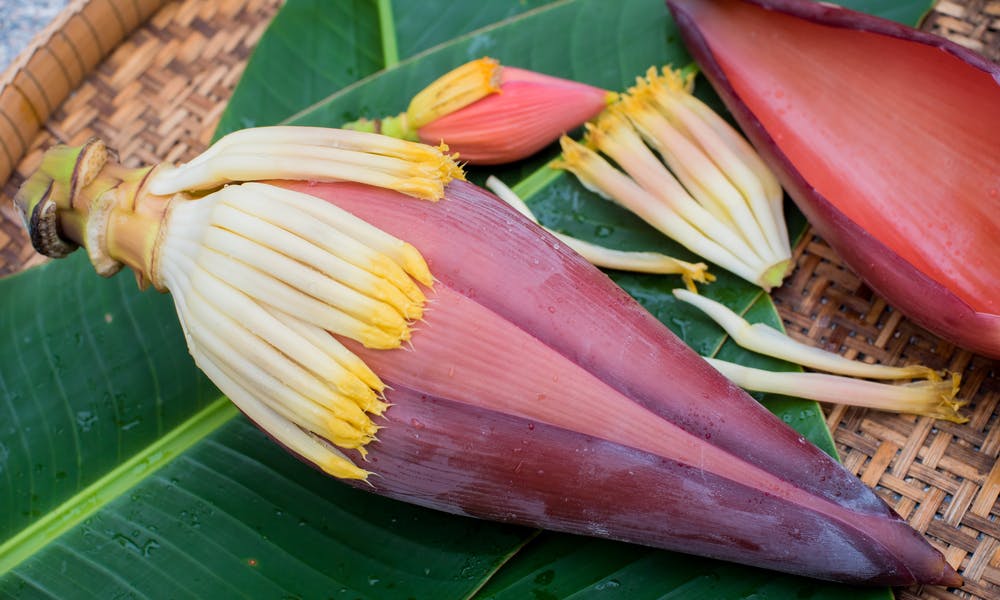The banana plant, home to the banana blossom, is a popular fruit bearing plant that we all know and love. A mainstay in the Orient, the banana plant is one of nature’s most useful children, with every part of the plant, from stem to leaf, being used in a variety of ways, from cups to textiles and more, with centuries of history behind it. We dive deep into all the fascinating ways it has become a part of cultures around the world, from its native origins to the art of growing your own.
Keep on reading to find out:
- The Banana Blossom History
- Banana Blossom Specs
- The Versatile Banana Plant
- Bananas Vs Plantains
- Use in Cuisine
- Growing Your Own
The Banana Blossom History
Native to most parts of south and southeast Asia, as well as Australia, the banana plant is one of the world’s biggest fruit crops. Close to 140 countries cultivate bananas now, with India and China being the largest producers. The name banana is thought to stem from the West African word banaana, which was passed into the English language through Spain or Portugal. Carl Linnaeus was responsible for creating the genus Musa, of which the banana tree is part of. The term musa is possibly from the Arabic word for banana, mauz. The two most common banana tree species in usage are the Musa sapientum and the Musa paradisiaca, bearing the dessert banana and plantain.
Banana Blossom Specs
Grown from a corm, the banana plant is the largest herbaceous flowering plant in existence. The plant is very often mistaken for a tree due its tall stature, when in reality what appears to be a trunk is a pseudo stem. The plants can grow anywhere from 3 feet to 23 feet. Banana plant leaves, growing around 9 feet long, are made up of a petiole and a lamina. Once the plant has matured, each of the pseudo stems produce one sole inflorescence, sometimes referred to as the banana heart. The inflorescence is made up of many bracts, spaced between a series of flowers. These flower hearts, shaped somewhat like a teardrop, are quite elegant and have a lovely purple color. Each heart can produce up to 20 fruits. The banana plant is a perennial and can last for quite a few years.
The Versatile Banana Plant
There are very few plants as useful as the banana plant. Its leaves have been used in Asian cultures for many years as handy tools and within cuisine. Many countries in southeast Asia, including Indonesia, use it to protect food being grilled or fried from burning, or as a plate. In India, due to its flexible exterior and being waterproof, it has been used as a gourd for holding water or as a sort of disposable lunchbox. Banana fiber, made from bark of the plant and the stems, has been used to produce banana paper. In some countries these fibers, boiled and prepared in a variety of ways, are used in textiles, with tablecloths and other useful items being made. It is very important throughout Japanese culture as the highest quality fibers are eventually used to produce the traditional kimonos found around the country.
Bananas vs Plantains
There is wide dispute over whether there is any real difference between plantains and bananas. Many of the commercial selling points focus on the fact that the plantain requires cooking whereas the banana does not, but in many Asian cultures the plantain is eaten raw in some instances, and bananas are widely used in cooking. For those who do care, the main difference seems to be of starch content. The plantain has a higher amount of starch within it, which gives it a bit of a creamier texture, and makes it less sweet than its banana counterpart.
Use in Cuisine
The fruit of the banana plant are commonly used as desserts, snacks, as well as in cultural cuisines the world over. Plantains can be fried for a minute or two, with a dash of cinnamon and sea salt giving it an exquisite taste. Many South American and African cultures simply boil plantains and mash them up after, a bit like potatoes. Like artichokes, banana flowers are used in south Asian cuisine as well, mixed commonly in soups and stews, as well as in fried meals. The flowers are often used in salads as well. Countries such as the Philippines and Burma even use the core of the banana plants pseudo stem in some dishes such as the inubaran or mohinga.
Growing Your Own
The first step in growing your banana plant is choosing an ideal location. Due to its size, it requires a lot of room, so make sure to take that into account. Choosing a spot that maximizes the plants benefits is a good idea, such as in an area that can use it as a windbreak or as shade for other plants.
The banana plant needs very rich soil to grow, so using large amounts of compost, such as chicken manure is best. Wood ash is handy as well, being a good source of potassium for the plant. The more mulch and organic matter you put, the better its growth, so don’t be shy. Banana plants like lots of humidity, but do not do well with high heat, so keep that in mind when deciding whether you live in the right environment for it. Ideal temperatures range from 26-30 degrees Celsius. Watering them at least twice a day is often recommended.
The Handy Banana Plant
Whether looking at its lovely flowers or growing it as a source of food, the banana plant is one of the handiest plants to have around. For those looking to add a bit of shade to their yards, there aren’t many plants that can offer as much as the banana plant, so don’t hesitate to add one to your home.
